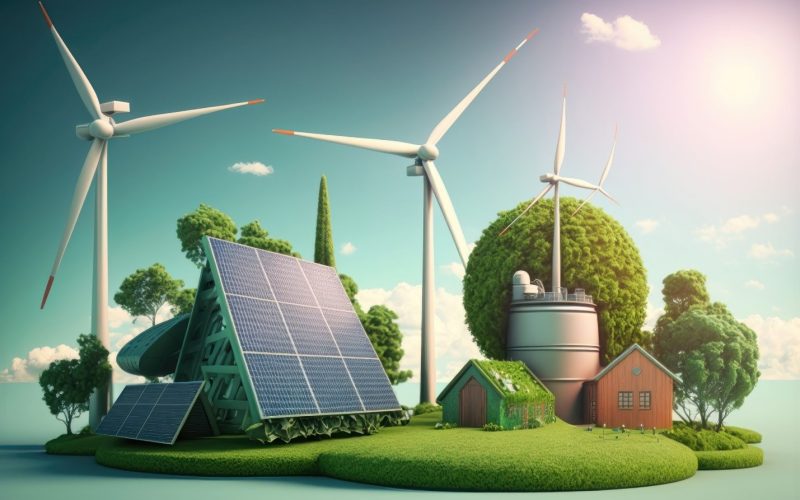Advancements in Renewable Energy: Innovations and Challenges
As the world grapples with the escalating impacts of climate change, the push towards renewable energy has become more urgent than ever. The transition from fossil fuels to renewable energy sources is not just a necessity for environmental sustainability but also a beacon of technological innovation and economic opportunity. This article delves into the recent advancements in renewable energy, the innovations driving this sector forward, and the challenges that still need to be addressed.
Solar Power: Harnessing the Sun’s Potential
Solar power has seen significant advancements over the past decade, making it one of the most promising renewable energy sources. Photovoltaic (PV) technology, which converts sunlight directly into electricity, has become more efficient and cost-effective. Innovations such as bifacial solar panels, which capture sunlight on both sides, and perovskite solar cells, known for their high efficiency and low production costs, are revolutionizing the industry.
Moreover, solar power storage solutions have improved, addressing one of the critical challenges of solar energy—its intermittency. Advanced battery technologies, including lithium-ion and solid-state batteries, provide more reliable and longer-lasting storage options. These advancements ensure that solar energy can be stored and used even when the sun is not shining, making it a more dependable energy source.
Wind Energy: Capturing the Power of the Wind
Wind energy has also made remarkable strides, with innovations in turbine technology leading the charge. Modern wind turbines are larger, more efficient, and capable of generating more electricity than ever before. Offshore wind farms, which harness the stronger and more consistent winds over the ocean, are becoming increasingly prevalent. Floating wind turbines, a relatively new innovation, allow for wind farms to be installed in deeper waters where traditional fixed-bottom turbines are not feasible.
Additionally, advancements in materials science have led to the development of lighter and more durable turbine blades, reducing maintenance costs and increasing the lifespan of wind turbines. These innovations contribute to the growing competitiveness of wind energy in the global energy market.

Hydropower: Tapping into Water’s Energy
Hydropower remains one of the most established forms of renewable energy, but it is not without its innovations. Small-scale hydropower systems, known as micro-hydro, are gaining traction, especially in remote areas. These systems can generate electricity from small streams and rivers, providing a sustainable energy source for communities without access to the grid.
Moreover, advancements in turbine design and fish-friendly technologies are addressing some of the environmental concerns associated with traditional hydropower plants. These innovations help to minimize the impact on aquatic ecosystems while maximizing energy output.
Biomass Energy: Converting Waste to Power
Biomass energy, which involves converting organic materials into electricity, heat, or biofuels, has seen significant advancements. Technologies such as anaerobic digestion, which breaks down organic waste to produce biogas, and advanced biofuels, derived from non-food crops and agricultural residues, are making biomass a more viable and sustainable energy source.
One of the key innovations in this sector is the development of biorefineries, which can process various types of biomass into multiple products, including energy, chemicals, and materials. This integrated approach maximizes the value of biomass and reduces waste, contributing to a circular economy.
Geothermal Energy: Unlocking Earth’s Heat
Geothermal energy, which harnesses the heat from beneath the Earth’s surface, is another area of significant innovation. Enhanced geothermal systems (EGS) are a groundbreaking technology that involves creating artificial reservoirs in hot rock formations to extract heat. This technology has the potential to expand geothermal energy production to regions where conventional geothermal resources are not available.
Additionally, advancements in drilling techniques and reservoir management are increasing the efficiency and sustainability of geothermal energy projects. These innovations make geothermal energy a more attractive option for baseload power generation, providing a constant and reliable energy source.
Challenges in Renewable Energy
Despite the remarkable advancements, the renewable energy sector faces several challenges that must be addressed to achieve a sustainable energy future.
Intermittency and Storage
One of the primary challenges of renewable energy sources like solar and wind is their intermittency. The sun does not always shine, and the wind does not always blow, leading to fluctuations in energy production. While advancements in battery storage are promising, large-scale and cost-effective storage solutions are still needed to ensure a stable and reliable energy supply.
Grid Integration
Integrating renewable energy into existing power grids poses technical and logistical challenges. The variability of renewable energy requires advanced grid management systems, including smart grids and demand response technologies, to balance supply and demand effectively. Upgrading infrastructure to accommodate distributed energy resources is also a significant undertaking.
Environmental and Social Impact
While renewable energy sources are generally more environmentally friendly than fossil fuels, they are not without their impacts. For instance, large-scale solar farms and wind turbines can affect local ecosystems and wildlife. Hydropower projects can disrupt aquatic habitats and displace communities. Addressing these environmental and social concerns is crucial for the sustainable development of renewable energy.
Economic and Policy Barriers
The transition to renewable energy requires substantial investment and supportive policies. While the cost of renewable energy technologies has decreased significantly, initial capital costs can still be a barrier, particularly in developing countries. Policy frameworks that provide incentives for renewable energy adoption and phase out subsidies for fossil fuels are essential to drive this transition.
Conclusion
The advancements in renewable energy technologies are paving the way for a more sustainable and resilient energy future. Innovations in solar, wind, hydropower, biomass, and geothermal energy are making these sources more efficient, cost-effective, and accessible. However, addressing the challenges of intermittency, grid integration, environmental impact, and economic barriers is critical to realizing the full potential of renewable energy.
As we continue to innovate and invest in renewable energy, collaboration between governments, industry, and communities will be essential. By working together, we can overcome the challenges and harness the power of renewable energy to create a cleaner, more sustainable world for future generations.











